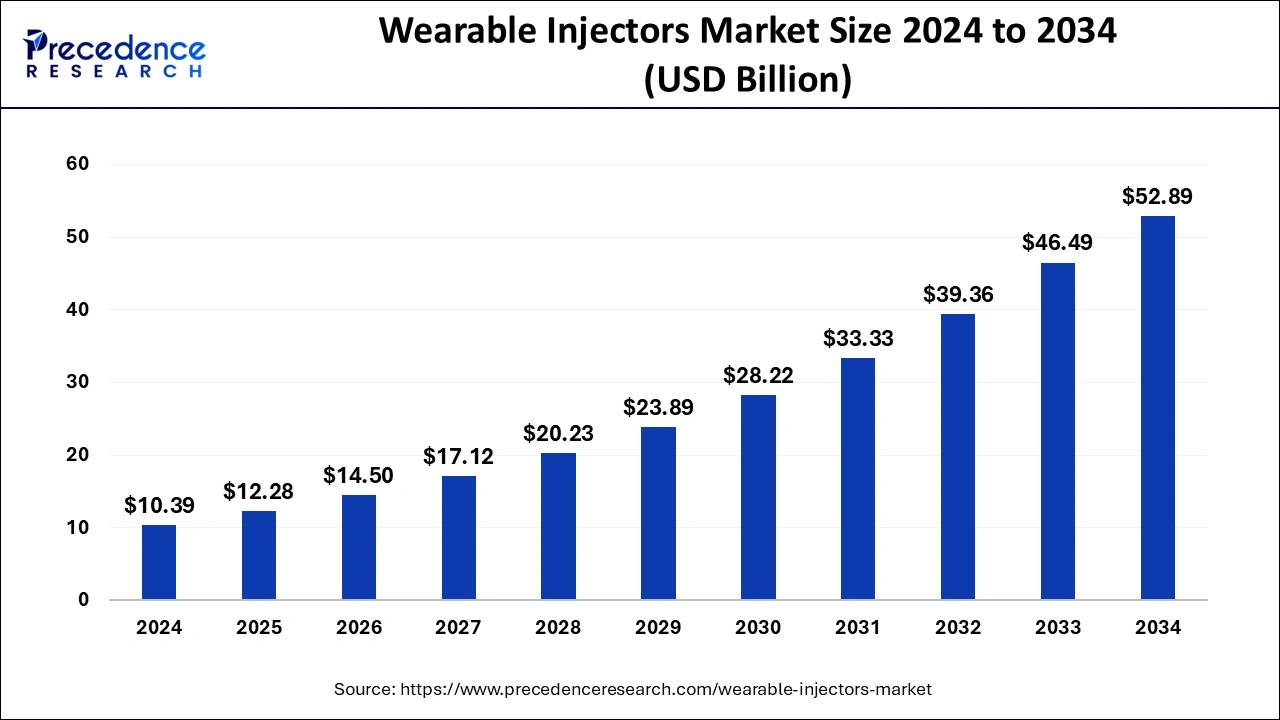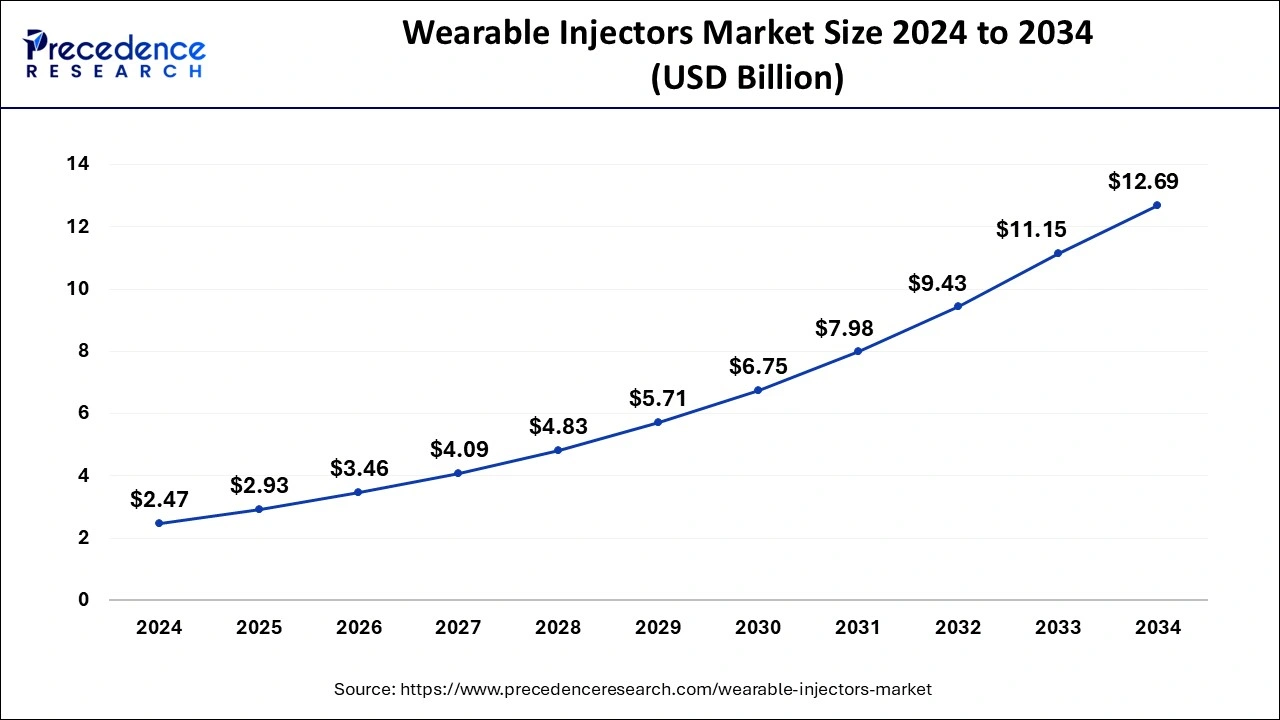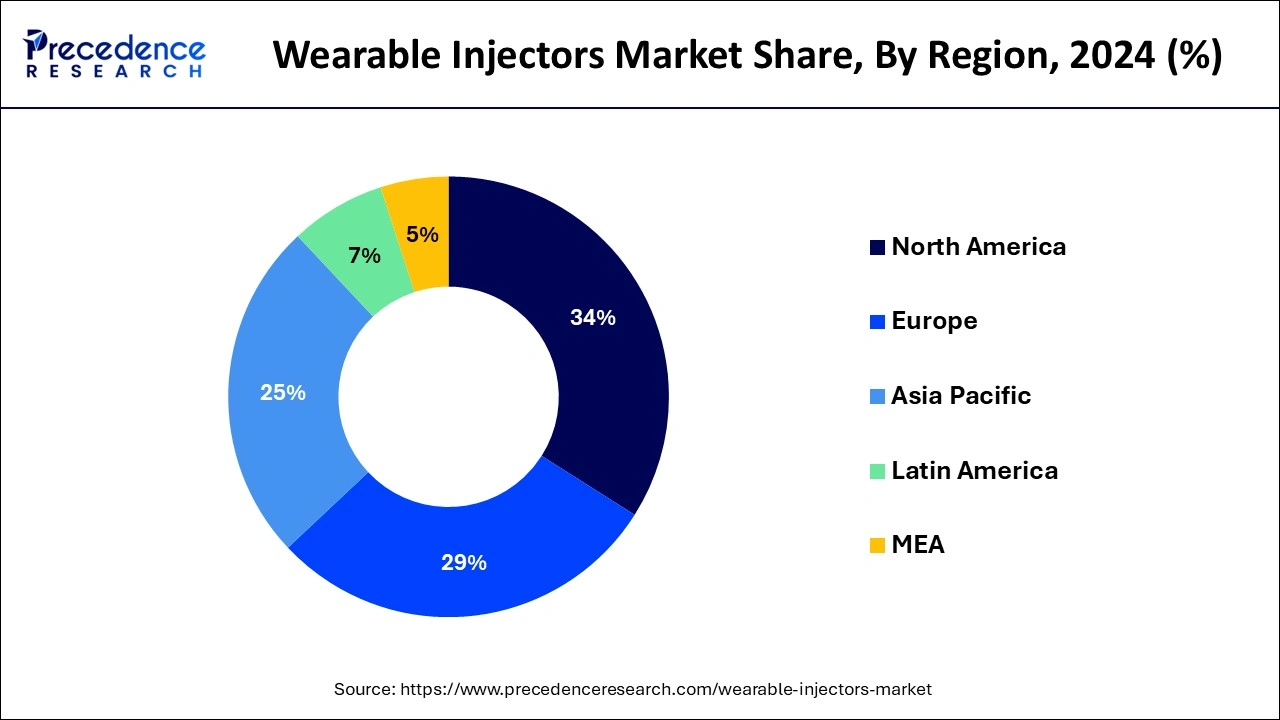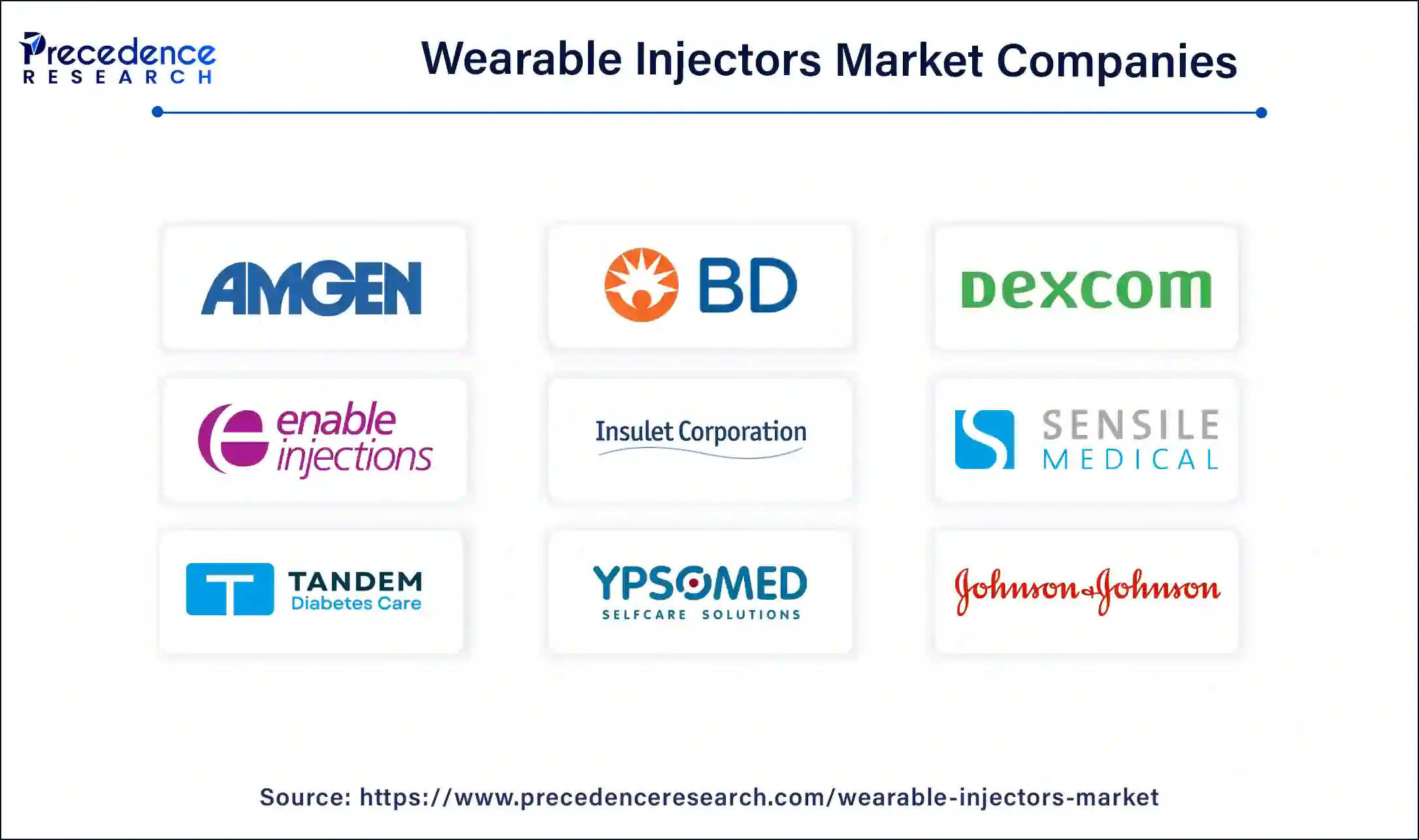January 2025
The global wearable injectors market size is estimated at USD 12.28 billion in 2025 and is anticipated to reach around USD 52.89 billion by 2034, expanding at a CAGR of 17.67% from 2025 to 2034. The North America wearable injectors market size was estimated at USD 3.53 billion in 2024 and is expanding at a CAGR of 17.80% during the forecast period. The market sizing and forecasts are revenue-based (USD Million/Billion), with 2024 as the base year.
The global wearable injectors market size accounted for USD 10.39 billion in 2024 and is predicted to reach around USD 52.89 billion by 2034, growing at a CAGR of 17.67% from 2025 to 2034.

The global wearable injectors market size was valued at USD 2.47 billion in 2024 and is expected to be worth around USD 12.69 billion by 2034, at a CAGR of 18% from 2025 to 2034.

North America dominated the global wearable injector market in 2024, in terms of revenue and is estimated to sustain its dominance during the forecast period. This is attributed to the increased number of people suffering from various chronic diseases. According to a study, around 60% of the US population is suffering from at least one chronic disease. Moreover, the development of various innovative drugs that can effectively treat chronic diseases is fueling the demand for the wearable injector market. Moreover, the rising popularity of personalized medicines may impact the market positively in the forthcoming years.

Asia Pacific is estimated to be the most opportunistic market during the forecast period. Asia Pacific is home to several top biopharmaceutical manufacturers. The nations like India, China, and South Korea are expected to present lucrative opportunities to market players in the upcoming future. Moreover, the rising old-age population in the region is expected to drive the demand for wearable injectors. Geriatric people are more prone to various chronic diseases and are expected to foster market growth in the foreseeable future. According to the WHO, by 2050, around 80% of the geriatric population will be living in low and middle-income economies.
Wearable Injectors are medical devices that are worn on the body to inject drugs. They are an alternative to traditional syringes and are used to administer insulin to diabetes patients. The wearable injectors market is experiencing significant growth due to the rising trend of self-medication and the demand for home-based treatment. Thus, people are seeking ways to manage their health independently. However, these injectors allow people to take their medications on their own, reducing discomfort and improving overall health outcomes.
The inconveniences like needle stick injuries and limitations of traditional syringes have encouraged the adoption of the latest wearable injectors among the population. The wearable injectors eliminate the requirement of any assistance from healthcare workers and also reduce the consumer’s expenditure on healthcare. Moreover, the wearable injectors are compact and portable and allow the patient to self-administer the drugs while conveniently doing regular tasks at home or office. All these benefits offered by wearable injectors are expected to drive the demand for wearable injectors among the population during the forecast period. Moreover, technological advancements led to the development of new and innovative drugs, which requires special drug delivery devices to efficiently administer the drugs in the patient’s body. Thus rapidly growing biopharmaceutical industry is boosting the development of new and innovative drugs that subsequently fosters the growth of the global wearable injector market across the globe.
The global wearable injector market is primarily driven by the growing prevalence of various chronic diseases such as cancer, rheumatoid arthritis, diabetes, cardiovascular diseases, and other chronic diseases coupled with technological advancements in drug delivery devices. Moreover, CVD accounted for around 32% of global deaths in 2019. The rapid growth of the biopharmaceuticals and development of various drugs that can cure chronic diseases efficiently fostered the demand for drug delivery devices across the globe.
| Report Highlights | Details |
| Market Size in 2024 | USD 10.39 Billion |
| Market Size in 2025 | USD 12.28 Billion |
| Market Size BY 2034 | USD 52.89 Billion |
| Growth Rate from 2025 to 2034 | CAGR of 17.67% |
| Largest Market | North America |
| Base Year | 2024 |
| Forecast Period | 2025 to 2034 |
| Segments Covered | Type, Application, End User, Region |
| Regions Covered | North America, Europe, Asia-Pacific, Latin America, and Middle East & Africa |
Chronic Disease Burden
The growing prevalence of chronic diseases, such as cancer, rheumatoid arthritis, diabetes, cardiovascular diseases, and other chronic diseases, is a major factor driving the global wearable injectors market. Some chronic diseases, such as dibetes, often require regular medication to manage symptoms, which significantly boosts the demand for wearable injectors. According to the World Health Organization (WHO), chronic diseases kill about 41 million people every year, which is equivalent to 74% of all deaths worldwide.
High Cost
Wearable injectors are expensive, which may deter potential users from adopting them. This, in turn, limits their widespread adoption. Moreover, the availability of oral insulin as alternative method for drug delivery is expected to hamper the market. Oral insulin is easy to take, effective, and safe, thereby boosting their demand.
Technological Advancements
Technological advancements in drug delivery devices create immense opportunities in the wearable injectors market. Advancements in design are making drug delivery devices, including wearable injectors, user-friendly. Moreover, the rising demand for personalized treatments that can cure chronic diseases efficiently boosts the demand for drug delivery devices across the globe.
Based on the type, the on-body segment accounted for over 56% of the market share in 2024. The on-body wearable injectors are easy to wear and comfortable for the skin. This has led to the extensive adoption of on-body injectors, thereby propelling the growth of this segment. Moreover, the rising demand for home care is expected to boost the segment’s growth in the forthcoming years.
On the other hand, the off-body is estimated to be the fastest-growing segment during the forecast period. The off-body wearable injectors eliminate certain inconveniences such as adhesive fitting on the skin, painful removal of injectors, and skin irritation. The rising investments in the development of enhanced off-body injectors are expected to drive the growth of this segment in the future.
The oncology segment dominated the global wearable injector market in 2024, in terms of revenue and is estimated to sustain its dominance during the forecast period. This is attributed to the increased prevalence of cancer among the population. The increased prevalence of various cancer such as breast cancer, lung cancer, bowel cancer, and womb cancer are the major drivers of this segment.
On the other hand, autoimmune diseases are estimated to be the most opportunistic segment during the forecast period. This can be attributed to the rising prevalence of diabetes among the population and the rising demand for wearable injectors over traditional insulin pumps. According to the World Health Organization, diabetes is the major cause of kidney failure, heart attacks, blindness, and stroke. Hence, the demand for the treatment for diabetes is expected to drive the growth of this segment.
The homecare segment accounted for over 41% of the market share in 2024. The increased awareness regarding wearable injectors and increasing preferences for self-injecting of drugs. Moreover, the reduction in the costs of healthcare associated with the homecare segment and the elimination of any assistance for the administration of drugs using wearable injectors are the major drivers of this segment.

By Type
By Application
By End User
By Geography
For inquiries regarding discounts, bulk purchases, or customization requests, please contact us at sales@precedenceresearch.com
No cookie-cutter, only authentic analysis – take the 1st step to become a Precedence Research client
January 2025
December 2024
May 2024
August 2024